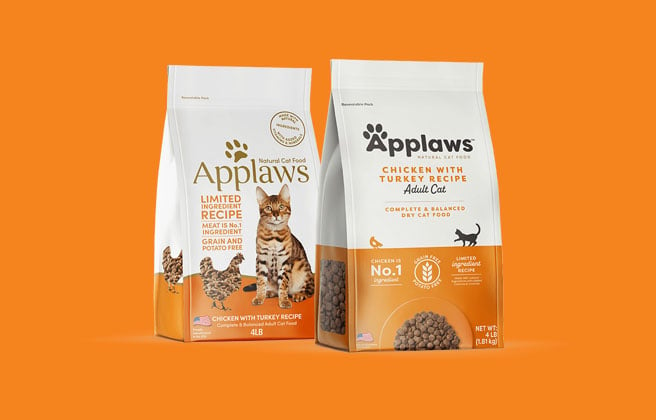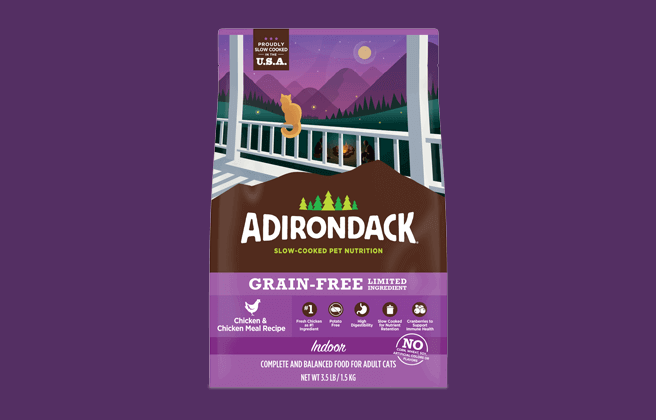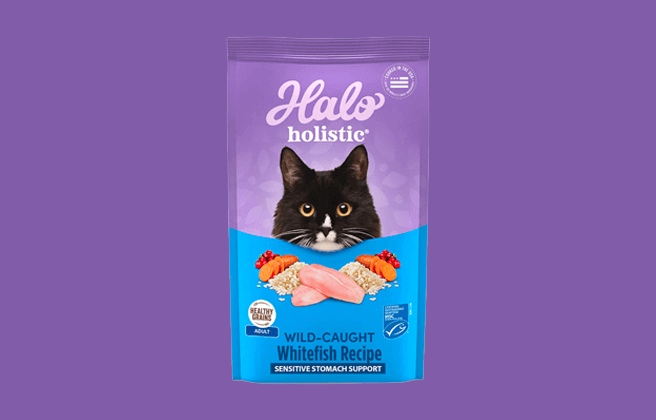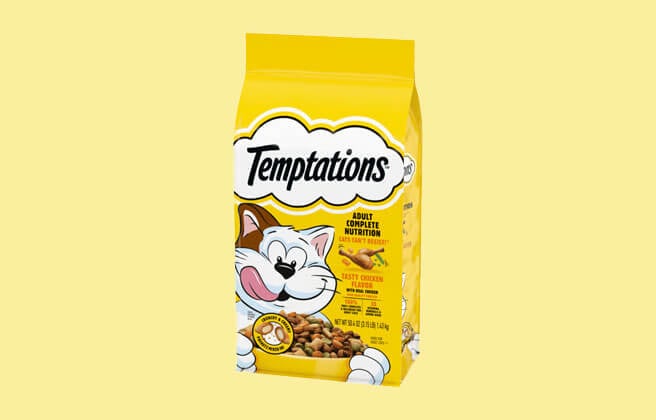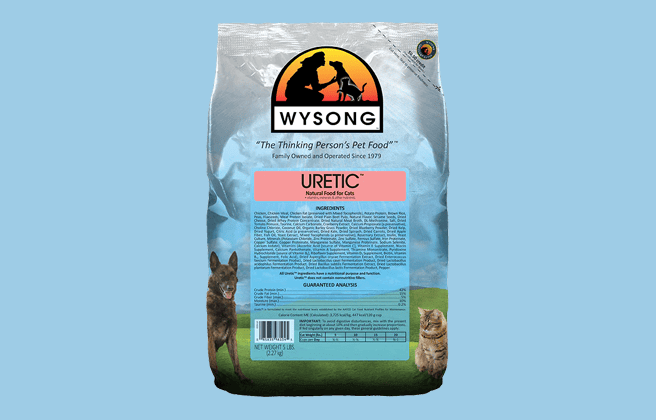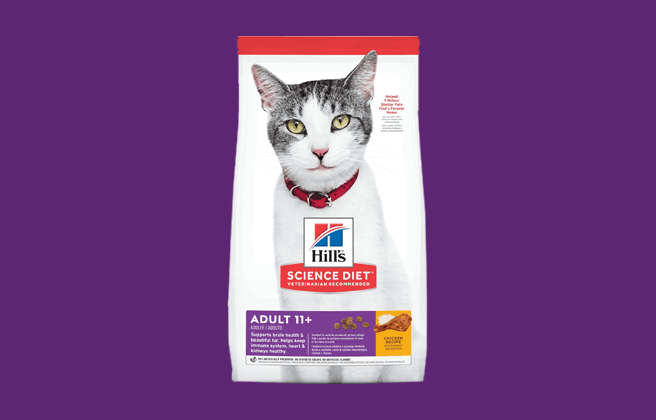
Our Verdict
BLUE Natural Veterinary Diet dry cat food is made up of five recipes with ratings that vary from 2.5 to 4.5. The average rating of the brand over all is 3.5 stars.
Please note: These foods receive a lower rating than normal because the criteria we use to rate foods does not always apply to recipes formulated for specific health conditions. Some ingredients would be considered controversial and marked down in foods for healthy cats, but are necessary in formulas that tackle certain issues/concerns.
Pros
- The first ingredient listed is quality animal protein, or fish
- No meat by-products
- No corn, wheat or soy
Cons
- Contains plant protein
The table below shows each recipe in this range including our rating and the AAFCO nutrient profile: Growth (kitten), Maintenance (adult), All Life Stages, Supplemental or Unspecified.
| Product line | Rating | AAFCO |
|---|---|---|
| Blue Natural Veterinary Diet HF Hydrolyzed for Food Intolerance | 3 | M |
| Blue Natural Veterinary Diet GI Gastrointestinal Support | 4.5 | M |
| Blue Natural Veterinary Diet W+U Weight Management & Urinary Care | 3.5 | M |
| Blue Natural Veterinary Diet K+M Kidney & Mobility Support | 2.5 | M |
| Blue Natural Veterinary Diet NP Novel Protein | 3 | A |
Save up to 35%
with Autoship
See discount in cart
Recipe and Label Analysis
Blue Buffalo Blue Natural Veterinary Diet GI Gastrointestinal Support recipe was selected to represent the other products in the line for a detailed recipe and nutrient analysis.
Label and nutrient data below are calculated using dry matter basis.
Blue Buffalo Blue Natural Veterinary Diet GI Gastrointestinal Support recipe
Estimated Dry Matter Nutrient Content
Protein
Fat
CarbsCarbohydrates
Deboned chicken, chicken meal, tapioca starch, peas, pea protein, turkey meal, dried egg product, chicken fat (preserved with mixed tocopherols), flaxseed (source of omega 3 and 6 fatty acids), pea fiber, natural flavor, potatoes, apple pomace, pumpkin, potassium chloride, dl-methionine, cranberries, choline chloride, calcium sulfate, l-threonine, dried kelp, dried chicory root, dehydrated alfalfa meal, calcium chloride, alfalfa nutrient concentrate, taurine, calcium carbonate, salt, l-tryptophan, vitamin E supplement, sweet potatoes, carrots, preserved with mixed tocopherols, iron amino acid chelate, zinc amino acid chelate, l-ascorbyl-2-polyphosphate (source of vitamin C), vegetable juice for color, niacin (vitamin B3), copper amino acid chelate, blueberries, barley grass, parsley, turmeric, yucca schidigera extract, manganese amino acid chelate, thiamine mononitrate, (vitamin B1), l-lysine, biotin (vitamin B7), vitamin A supplement, pyridoxine hydrochloride (vitamin B6), calcium pantothenate (vitamin B5), riboflavin (vitamin B2), ferrous sulfate, zinc sulfate, vitamin D3 supplement, vitamin B12 supplement, folic acid (vitamin B9), copper sulfate, dried yeast, dried enterococcus faecium fermentation product, dried lactobacillus acidophilus fermentation product, dried aspergillus niger fermentation extract, dried trichoderma longibrachiatum fermentation extract, dried bacillus subtilis fermentation extract , dried bacillus subtilis fermentation extract, manganese sulfate, calcium iodate, sodium selenite, oil of rosemary.
Fiber (estimated dry matter content) = 5%
Red denotes any controversial items
Ingredients Analysis
The first ingredient is deboned chicken, which is considered “the clean combination of flesh and skin… derived from the parts or whole carcasses of chicken”. 1
Chicken is naturally rich in the 11 essential amino acids required by a cat to sustain life.
The second ingredient is chicken meal. Chicken meal is considered a meat concentrate and contains nearly 300% more protein than fresh chicken.
The third ingredient is tapioca, a gluten-free, starchy carbohydrate extract made from the root of the cassava plant.
The fourth ingredient is peas. Peas are a quality source of carbohydrates. And like all legumes, they’re rich in natural fiber.
However, peas contain about 25% protein, a factor that must be considered when judging the meat content of this cat food.
The fifth ingredient is pea protein, what remains of a pea after removing the starchy part of the vegetable.
Even though it contains over 80% protein, this ingredient would be expected to have a lower biological value than meat.
And less costly plant-based products like this can notably boost the total protein reported on the label — a factor that must be considered when judging the meat content of this cat food.
The sixth ingredient is turkey meal. Turkey meal is considered a meat concentrate and contains nearly 300% more protein than fresh turkey.
The seventh ingredient is dried egg product, a dehydrated form of shell-free eggs. Quality can vary significantly. Lower grade egg products can even come from commercial hatcheries – from eggs that have failed to hatch.
In any case, eggs are easy to digest and have an exceptionally high biological value.
The eighth ingredient is chicken fat which is obtained from rendering chicken, a process similar to making soup in which the fat itself is skimmed from the surface of the liquid.
Chicken fat is high in linoleic acid, an omega-6 fatty acid essential for life. Although it doesn’t sound very appetizing, chicken fat is actually a quality ingredient.
From here the list goes on to include a number of other items. But to be realistic, ingredients located this far down the list (other than nutritional supplements) are not likely to affect the overall rating of the product.
However, this recipe contains dried fermentation products. Fermentation products are typically added as probiotics to aid with digestion.
In addition, this food also contains chelated minerals, minerals that have been chemically attached to protein. This makes them easier to absorb. Chelated minerals are usually found in better cat foods.
Save up to 35%
with Autoship
See discount in cart
Nutrient Analysis
Based on its ingredients alone, Blue Natural Veterinary Diet GI Gastrointestinal Support recipe looks like an average dry product.
The dashboard displays a dry matter protein reading of 45%, a fat level of 17.5% and an estimated carbohydrate level of 29.5%.
As a group, the brand features an near-average protein content of 36.3% and a mean fat level of 16.2%. Together these figures suggest a carbohydrate content of 39.5% for the overall product line, alongside a fat to protein ratio of 47%.
This means this Blue Naturals Veterinary Diet range contains near-average protein, higher than average carbohydrate and near-average fat, when compared to typical dry cat food.
Final Word
This veterinary diet range of food has been formulated to help support cats that have a range of different needs such as managing weight, food intolerances and gastrointestinal issues.
Has Blue Buffalo BLUE Natural cat food been recalled in the past?
Yes, Blue Buffalo has had a few recalls. The most recent cat food recall was in November 2015, when a small number of Blue Kitty Yums cat treats were recalled due to reports of propylene glycol.
In 2007 there were also multiple cat food recalls. Blue Buffalo Blue Spa Select canned cat food and Blue Buffalo Spa Select Kitten dry food were both recalled in April due to Melamine.
There have been other recalls, although these were for the following dog products:
- Blue Wilderness Rocky Mountain Recipe Red Meat Dinner Wet Food (March 2017)
- Blue Buffalo Homestyle Recipe Healthy Weight, Chicken Dinner With Garden Vegetables (February 2017)
- Blue Buffalo dog food cups (February 2017)
- Blue Buffalo Life Protection Formula Fish and Sweet Potato Recipe (May 2016)
- One lot of Cub Size Wilderness Wild Chews Bones (November 2015)
- Blue Buffalo dry dog food (October 2010)
- Blue Buffalo Blue canned dog food and dog treats (April 2007)
You can view a complete list of all cat food recalls since 2021 here.
To stay on top of any cat food product recalls, sign up for our free email alerts, here.
About
Blue Buffalo’s headquarters is in Wilton, Connecticut. It has two facilities, one in Missouri and a manufacturing plant in Indiana.
The company started from humble origins but is now owned by General Mills.
Best cat foods
We uphold the highest editorial standards when creating the authoritative content pet parents rely on and trust.
Every piece of clinical content on the Cat Food Advisor is reviewed by our certified Veterinary Advisory Board, which consists of licensed veterinarians and medically certified specialists.
Our reviews are completely independent; we are not paid by any pet food company to promote their products favorably. We do not accept money, gifts, samples or other incentives in exchange for special consideration. For more information see our Disclaimer & Disclosure page.







